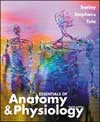 |  Essentials of Anatomy & Physiology, 4/e Rod R. Seeley,
Idaho State University
Philip Tate,
Phoenix College
Trent D. Stephens,
Idaho State University
Cell Structures and their Functions
Internet Activities
The Dictionary of Cell Biology
(http://www.mblab.gla.ac.uk/%7Ejulian/Dict.html)
This site contains a friendly and comprehensive dictionary related to cytology, histology, and molecular biology.
Question: What role does aquaporin play in membrane transport? |
 |  |  | Nucleic Acids
(http://esg-www.mit.edu:8001/esgbio/lm/nucleicacids/nucleicacids.html)
Diagrams of nucleotides and complementary base pairing in DNA are provided at this site.
Question: What does "complementary base pairing" mean? |
 |  |  | Nucleic Acids
(http://www-medlib.med.utah.edu/NetBiochem/nucacids.htm)
This site describes the structure of nucleic acids, the semiconservative nature of DNA synthesis, DNA repair, RNA synthesis, and the three major types of RNA.
Question: Why is the replication of DNA referred to as being semi-conservative? |
 |  |  | Cell Division: Binary Fission and Mitosis
(http://gened.emc.maricopa.edu/bio/bio181/BIOBK/BioBookmito.html)
This site provides a detailed text description of cell division.
Question: On a piece of paper, sketch and describe the stages of cell division. |
|



 2002 McGraw-Hill Higher Education
2002 McGraw-Hill Higher Education